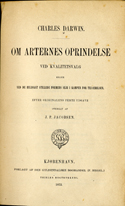Origin of Species
On the Origin of Species namely Om Arternes Oprindelse was published in 1872 and reprinted in a new edition in 1909 (the Darwin centenary and 50th anniversary of the Origin). An abridged edition appeared in 1913. The 1909 edition was reprinted in 1967, 1981 and 1999. The fifth edition of The Origin of Species (1869) was translated by Jens Peter Jacobsen (1847-1885) who was still at the beginning of his career and rather unknown to the general public at the time. Jacobsen was a skilled botanist and an author of fiction. Later he became famous as one of the pioneers of the literary period known as 'the modern breakthrough'. His translation of On the Origin of Species was first published as booklets entitled Naturlivets Grundlove [The Laws of Nature] offered at subscription rates. The first booklet appeared in 1871. In a review of the translation the title was criticised for being too far from the title of Darwin’s original book. Consequently the title was changed into a more literal translation of the original title when the booklets were collected in a single volume and published as Om Arternes Oprindelse in 1872.
The title Naturlivets Grundlove was not the only thing that differed from the original version of the book. The five illustrations of different breeds of doves in the first chapter of Om Arternes Oprindelse (pp. 28-32), did not originally appear in On the Origin of Species - they were added from another work by Darwin: Variation of animals and plants under domestication (1868). In 1868 the Danish libraries Det Kongelige Bibliotek [the Royal Library], Universitetsbiblioteket [the University Library] and Landbohøjskolens Biblitotek [the library of the Royal Veterinary and Agricultural College] each had a copy of Variation of animals and plants under domestication. From 1859-1870 the three libraries bought seven copies of On the origin of species in total (three English and four German). When Om Arternes Oprindelse was published, the price was 8 DKK (about a week’s salary for an unskilled labourer), many couldn’t afford to buy the book and hence there was a great demand for the libraries’ copies. The second edition from 1909 was priced at 6 DKK and the third abridged edition from 1913 was priced at 2 DKK making it more affordable to the general public.
When Om Arternes Oprindelse was published, Darwin and his theories were already well known in Denmark. Darwinism had been the subject of several lectures, books and articles in journals, newspapers and popular magazines throughout the 1860s. One of the early advocates for Darwinism was the journalist Rudolf Varberg (1828-1869) who wrote several popular books and articles on the subject and used Darwinism as a vehicle to criticise contemporary Danish zoology, more specifically the professor of zoology Japetus Steenstrup.
In 1870 Vilhelm Møller (1846-1904), a literary scholar (or as he would be known in the 19th century - "a man of letters), founded the journal Nyt dansk Maanedsskrift [New Danish monthly] and encouraged Jens Peter Jacobsen to write a series of articles about Darwinism. These were published in Nyt dansk Maanedsskrift in 1871-72. Jacobsen wrote the articles while translating On the origin of species. In 1893 Møller collected Jacobsen’s articles and a biography written by himself in a book entitled Darwin hans liv og hans lære [Darwin: his Life and Work]. According to Møller his reason for republishing the articles in a book was a large number of requests, because of a public interest in Jacobsen (who, after his death, had become a famous author) and because they provided an 'entertaining presentation' of Darwinism. The articles were widely read.
Jacobsen and Møller were both part of a radical group rallied around the literary critic Georg Brandes (1842-1927). Nyt dansk Maanedskrift served as their mouthpiece. The group was advocating 'freedom of thought', i.e. that religious dogmatism and outdated traditions should be replaced by science and reason. They saw a conflict between science and religion in which science had come out victorious with Copernicus having taken the first step towards the end of religious dogmatism and Darwin the second. According to Jacobsen and Brandes, Darwinism was a theory capable of explaining everything about life through science and thereby making religion superfluous to explain supposed miracles. Even human nature and ethics were described in Darwinian terms.
Consequently, a lot of the debates following the publication of Jacobsen’s translation of Origin of Species focused on Jacobsen and Brandes’s interpretation of Darwinism as atheism, rather than on the content of Om Arternes Oprindelse. Its content having already been discussed and presented to the public in the 1860s.
Stine Grumsen










